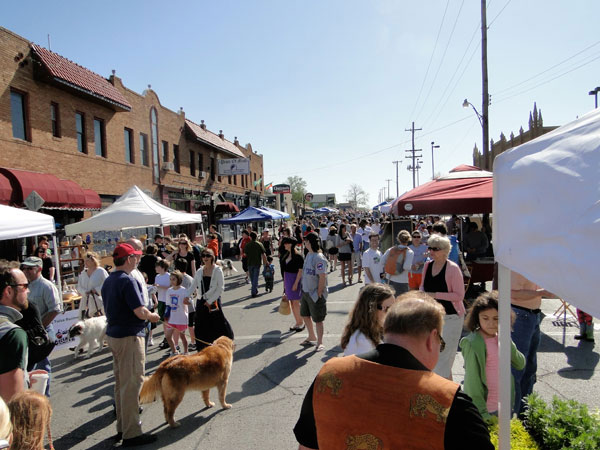Swan Lake: Tulsa, Oklahoma

Summary
Replete with swans — real and handcrafted — Swan Lake is an idyllic neighborhood a mile and a half from downtown Tulsa. The neighborhood has made frequent use of the bird as a decorative motif ever since architect Joseph Koberling incorporated a swan into the facade of his French Eclectic-style stone house in 1944. Plaques, planters, and statuary featuring the graceful bird attest to the continuing sense of identity and cohesiveness of this historic neighborhood.
Designated Area
The neighborhood encompasses 127 acres that are bounded by 15th and 21st Streets to the north and south and Peoria and Utica Avenues to the east and west.

Within easy walking distance of Swan Lake residences, the popular Cherry Street retail and restaurant corridor also hosts a regular farmers market. Photo Brian McCullough.
Planning Excellence
Originally a streetcar suburb designed for the middle class, the neighborhood's lakefront views attracted more affluent Tulsans. From the first house built on the lake in 1919, a stunning Italian Renaissance structure, to The Natatorium, a 1926 Monterrey-Spanish Eclectic home built on the former site of an amusement park swimming pool, Swan Lake features a mix of some two dozen architectural styles.
What dominates this attractive and popular neighborhood are the well-maintained sturdy bungalows built along tree-lined streets between 1920 and 1930. Apartment buildings, which meshed with the development's middle-class appeal, appeared on outlying streets as early as 1918. One innovative apartment complex built in 1929 featured a courtyard at its center to provide outdoor recreation space for its tenants. Duplexes and garage apartments — many from Swan Lake's earliest days — continue to attract singles, young couples, and empty-nesters.
Once a spring-fed watering hole, Swan Lake eventually became a community gathering place and the site of a 1910 amusement park. Today the lake and surrounding park, a popular bird watching spot, are the focus of neighborhood attention as residents raise funds to restore a 1920s stone fountain.
Finding solutions to commercial encroachment is another focus of residents. The neighborhood is within easy walking distance of the very popular Cherry Street retail and restaurant corridor, several medical facilities, and other businesses. The Swan Lake Neighborhood Association, which initiated a successful effort to add a historic preservation zoning overlay, supports efforts to keep commercial development on the perimeter of the neighborhood from expanding into the residential district.

Well-maintained sturdy bungalows built between 1920 and 1930 are predominant in Swan Lake, which features a mix of some two dozen architectural styles. Photo Monty McElroy.
Defining Characteristics, Features
Natural and manmade beauty
- Gently rolling terrain features shaded streets bordered by sidewalks and well-kept yards
- Four-acre Swan Lake Park includes lake with lighted, ornamental stone fountain, 0.4-mile walking path, and stone benches; ideal for watching birds and waterfowl
- Thematic sculptures grace park; larger-than-life bronze of a trumpeter swan in-flight located at park entrance; "Enchantment," a boy with a swan, relocated from 1934 Chicago World's Fair
- Exceptional architecture includes late Gothic Revival building, Christ the King Church (1927). Francis Barry Byrne design incorporates Byzantine and Art Deco design elements; stained glass windows are nationally recognized. Elegant lakefront houses range from Dutch Colonial to Georgian to Monterrey-Spanish and French Eclectic
Original design and early history
- Designed for residents of moderate means; Orcutt Addition (1908) stresses affordability
- 187 modest bungalows and Craftsman-style houses — most of wood, some of stucco or brick — make up a third of the housing stock; Tudor Revival (80) and Colonial Revival (73) also popular
- Neighborhood developed concurrently with adjacent amusement park, which attracted potential buyers to area and caused extension of streetcar line (1910) to district
- After selling Orcutt Addition (1917), Augustus Orcutt invests in apartment buildings (1918); Utica Court (1929) built around a courtyard to provide tenants space for outdoor recreation
- Swan Lake's grid features mostly shorter blocks, which enhance pedestrian mobility, to the north and east of the lake
Active and engaged citizens, organizations
- Organized in 1983, Swan Lake Neighborhood Association launched a successful campaign (1992) to list neighborhood in the National Register of Historic Places (1998)
- City approves neighborhood petition for Historic Preservation overlay zoning for Swan Lake and adopts design guidelines (1994)
- Residents support legislative efforts (2011) to close loophole permitting commercial development within boundaries of Historic Preservation Zoning districts
- City council places a moratorium, to expire December 1, 2011, on use of planned unit developments to amend zoning in historic districts
- As part of implementing its recently adopted comprehensive plan, PLANiTulsa, City allocates $300,000 to develop three small-area plans, including one that incorporates those parts of Swan Lake adjacent to commercial and medical corridor
- Tulsa Parks and Swan Lake Waterfowl Society partner to ensure viability of resident swans and other riparian birds. Society cares for and feeds waterfowl; park staff maintains shore habitat
- Swan Lake Neighborhood Association undertakes $1.7 million fundraising effort to restore Swan Lake Park fountain, enhance lake water quality, improve fencing, establish an endowment
- Neighborhood events such as September block party, Halloween parade and costume contest, November's "Lights on Swan Lake" foster community spirit and public participation

The lake and surrounding park are popular for bird-watching and community gatherings. A pair of trumpeter swans lives in the lake. The stone fountain dates to the 1920s, and residents are currently raising funds to restore it. Photo Monty McElroy.
Amenities
- Most residences within short walk of commercial and retail businesses. Utica Square (1952), an upscale retail and entertainment center, located on neighborhood's southeastern border
- Three city bus routes serve neighborhood
- Adaptive reuse encouraged; historic Bellview-Lincoln Elementary School (1909) converted to shops and restaurants (1990s); neighborhood gathering place and site of a Farmers' Market
- Inn at Woodward Park (2004), a former distressed residence, is only ECO Gold-certified bed and breakfast in Oklahoma
- Marquette Park houses a neighborhood playground; Woodward Park, on Swan Lake's southwest border, home to the Tulsa Rose Garden, trails, playground, picnic areas, gazebo


